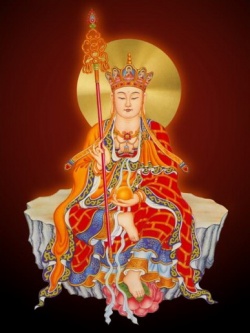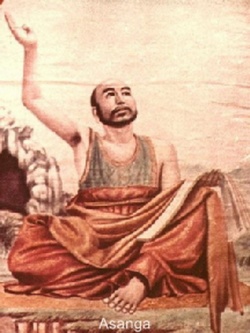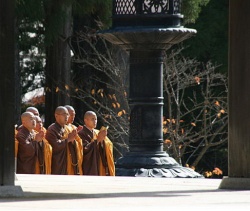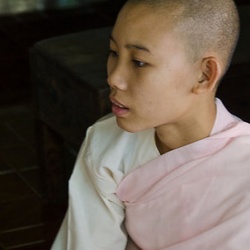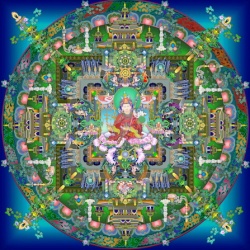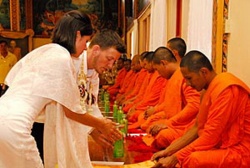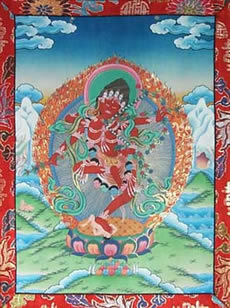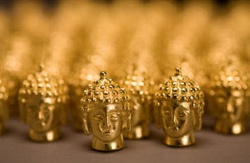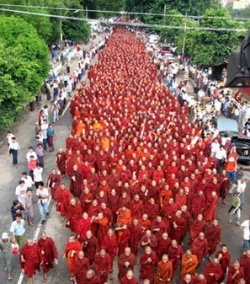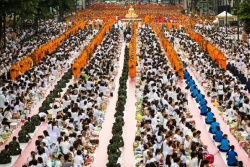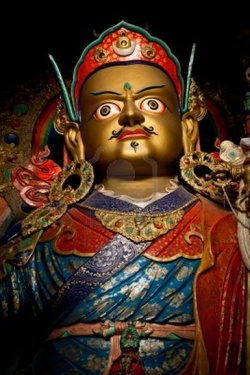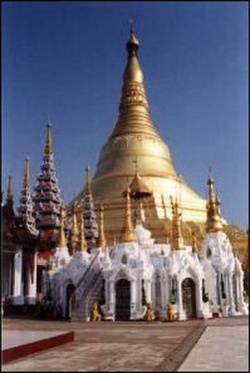An Atheist Perspective on Buddhism
The books and articles I refer to during this lecture may be found at atheistscholar.org, An Atheist Perspective on Buddhism. The bibliography is at the end of the written essay.
Buddhism’s proponents have managed to create a highly mistaken impression that Buddhism is compatible with atheism, that many types of Buddhism are, in fact, atheist. Strictly speaking, since most Buddhist belief systems eschew credence in a god, one might say they are atheism of a sort. They do not have a belief in the sort of god embraced by Christianity, Judaism, and Islam. However, as we shall see during this lecture, Buddhism is very remote from naturalistic, materialistic modern atheism.
This lecture will provide a brief overview of Buddhism and its beliefs. Then we shall look at the Buddhist lynchpins of reincarnation and karma. I have discussed the topic in an earlier lecture, The Illusion of Immortality, Part 2 at atheistscholar.org. So those listeners and readers who are familiar with that lecture may want to skip ahead to the last topic we shall be discussing. The final topic will be Zen Buddhism’s cooperation with the Japanese government, including its acquiescence and support of Japan’s wars, beginning with the Meiji period spanning the years 1868-1912 and continuing up until the end of World War II in 1945. The point of this examination will be to deny Buddhist claims that it is a peaceful, compassionate religion, compatible with science and modern thinking. My position, shared by many scholars, is that such claims are misleading, indeed, are fallacious.
While it is important to learn something about Buddhist tenets, the purpose of this lecture is primarily to demonstrate how Buddhism’s past and present philosophic positions and the egregious thinking and behavior partly stemming from those beliefs, are not very different from other religions. As the late atheist author, Christopher Hitchens noted, religion poisons everything. He was correct. Buddhism is a belief system encompassing a universe that has always existed and always will, souls that have existed since the beginning of time and always will, the taking for granted, in traditional Buddhism, polytheism and diverse realms that have nothing to do with the natural universe. Some Buddhist proponents would have us accept the notion that Buddhism is not truly a religion, but more a philosophical system.
So before I begin to discuss the Buddhist belief system, I would like to put the question of whether Buddhism is a religion to rest. I am going to list Nina Smart’s seven dimensions of religion. They are (1) practical and ritual, (2) experiential and emotional, (3) narrative and mythic, (4) doctrinal and philosophical, (5) ethical and legal, (6) social and institutional, and (7) material. Most Buddhist theologians have agreed, based on the above criteria, that Buddhism is indeed a religion.
The founder of Buddhism was Siddhartha Gautama, believed to have lived in India between 563 and 483 B.C.E. Most sources agree he was about eighty years old when he died. Traditionally, he is referred to as the Buddha, the Enlightened One. He tried to bring salvation to people by showing them how to escape from samsara, the notion of the endless cycle of birth and rebirth that is so central to Buddhist beliefs. The Buddha himself left no written work.
There was a long period of oral chanting of his precepts, four hundred years, before they were written down. The various recorded teachings are called “canons,” collections of scripture. The only one that has been preserved intact is the s0-called Pali Canon, written in Pali, a vernacular language close to Sanskrit and close to that spoken by the Buddha. It is interesting that both the birth and death of the Buddha were described as accompanied by diverse miracles, similar to those that frequently accompany other tales about gods or founders of religions, such as Jesus.
At some point in his life, Buddha became aware of what he believed was the source of human suffering, which he identified with desire. Buddha also apparently was able to recall a vast number of his own reincarnations. When he achieved enlightenment, he wandered throughout India preaching his doctrines. His first formal sermon was in a deer park near Benares, where he imparted his principle of The Four Noble Truths to former colleagues and attracted many new followers.
He appointed no successor at his death, as he said that he had never regarded himself as the “leader of the Order.” He advised his supporters to follow the Dharma, which laid out the essential doctrines of Buddhism, including The Four Noble Truths and the Vinaya, which was a code of rules for the monastic life. He believed people should think for themselves before deciding on which scriptures to believe. Because of this, there has never really been a centrist source of authority for Buddhism on matters of doctrine. No single institution or body has authority to promulgate dogma and creeds for the religion as a whole.
After the Buddha’s death, there arose many interpretations of his beliefs and sayings, and many disparate divisions of the religion into various schools. It is important to keep in mind that what I am describing in this lecture is a very general group of beliefs and traditions shared by most Buddhists. It is necessary to look at the precepts of the various sects and schools to know how certain doctrines are interpreted by each different group.
Buddhism, as I said earlier, attempts to teach people how to escape from what it calls samsara, the endless cycle of birth and rebirth which this religion takes for granted. Many Hindus also embrace the notion of samsara, but we shall limit ourselves to the Buddhist view alone for the purposes of this lecture. The bondage to life, death, and then rebirth into a new body is dictated by karma. Karma is the universal law of cause and effect which is applied to people’s deeds and behavior in each lifetime. A deliberate good or evil deed leads the person’s destiny in the appropriate direction. This working out of karma means the ripening of people’s deeds may take more than one lifetime. Karma may take many lifetimes of the rebirth cycle to develop. There are only a few exceptions: deeds free from desire or delusion apparently do not have karmic consequences.
Rebirth is not seen as a positive in Buddhism. Rather the purpose of the religion is put an end to the suffering and rebirth, and their endless cycles. Apparently samsara is not necessarily unending. The Buddha was supposed to have declared: “Both in the past and now, I set forth only this: suffering and the end of suffering.”
We shall discuss the path for an end to rebirth and suffering in a few minutes. But the ultimate goal of the escape from rebirth is to achieve nirvana.
Finniger Horth states that: “Nirvana is, in Buddhist thinking, ordinarily conceived as the complete extinction of individuality, but without total loss of consciousness. It is invariably described as a condition in which all pain, suffering, mental anguish and above all, samsara have ceased.” An atheist would generally believe that death ends all consciousness, but Buddhists believe that all painful kinds of consciousness disappear with the attainment of nirvana. However, there is room for some sort of bliss or happiness.
Nirvana, some scholars agree, cannot be reached by good deeds alone, that good deeds may actually inhibit reaching this blissful state. Good deeds are part of karma and its consequences, and karma produces rebirth. This theory is generally in dispute. But for many Buddhist schools, it is clear that leading a moral life is one component to reaching nirvana. The other element is wisdom. And some would also say meditation. Damien Keown explains that wisdom in Buddhism is a profound philosophical understanding of the human condition, requiring insight into the nature of reality of the kind which comes through reflection. It is, he states: “…a kind of gnosis, or direct apprehension of truth, which deepens over time and eventually reaches full maturity in the complete awakening experienced by Buddha.”
So what is it that a person must know to be enlightened? Buddha claimed he had discovered the truth on the night of his enlightenment. He first shared it with others when he gave his famous sermon in the deer park. There are Four Noble Truths in Buddhism, passed down from Buddha. These truths consist of several interrelated propositions, which are still the foundation of most Buddhist schools.
Before I begin with the Noble Truths, I would like to reiterate that my main point in this lecture is a condemnation or critique of religion, which has been a theme throughout this series of talks. But I do not believe the secular community has anything to gain by merely disparaging various religions and their belief systems without knowing, at the very least, something about them. So when we finish with the basic principles and credos of the Buddhist doctrine, we shall be in a strong position to judge its basic irrationality. Worse yet, however, will be the detailing of the hypocrisy and misuse of those high-minded principles, or what atheists might call fantasies, in the service of the state, and in the service of state-sponsored warfare.
Here then, are The Four Noble Truths of Buddhism. The first is the truth of suffering. Buddha laid out the various forms of physical and mental suffering people undergo. Birth, old age, disease, sorrow and not getting what we want are only a few of the reasons for suffering. He maintained that all life is suffering. The second truth is the truth of arising. Here the Buddha answered how suffering arises. He believed it came from craving that not only enjoys pleasure, but tries to gain more pleasure repeatedly. Craving thirsts after sensual pleasure, existence and non-existence, or the desire to destroy. Number three is the truth of cessation. I will quote the Buddha here: “It is the utter cessation of craving, the withdrawal from it, the renouncing of it, the rejection of it, the liberation from it, non-attachment to it.” Finally there is number four, the truth of the path. The path is supposed to lead to the end of suffering. Buddha had a prescribed course of behavior, consisting of a path which is divided between morality, meditation and wisdom, which we mentioned a few minutes ago.
This course is called the Eightfold Path. I am relying on several Buddhist scholars, particularly on the work of Keown, for this attenuated breakdown of the Eightfold Path. Wisdom encompasses right understanding and right resolve. Right understanding means acceptance of Buddhist teachings and then experimental confirmation of them. Right resolve is the serious attempt or commitment to developing right attitudes. Morality encompasses right speech, right action and right livelihood. Right speech entails telling the truth in a sensitive and thoughtful way. Right action is abstaining from wrongful bodily actions such as killing, stealing and behaving unethically concerning sensual pleasure. Right livelihood is not engaging in occupations which cause harm to others. Under Meditation, right effort means gaining control of one’s thoughts and cultivating positive states of mind. Right mindfulness means cultivating constant awareness and right meditation means embracing the various techniques which concentrate the mind and integrate the personality.
For me, the most interesting idea out of all the Buddhist propositions is the view of the anatman, the non-self or the illusion of self. Such a conception is very similar to David Hume’s thinking about the self. If you remember, Hume was the great skeptical philosopher of the 18th Century. However, Hume never embraced any idea of karma or reincarnation. He would likely have mocked such fancies. But he, many proponents of the Buddhist religion, and also many postmodern philosophers have given credence to some version of what is now called the “bundle theory” of the mind or self. We do not think correctly, according to the bundle theory, when we embrace the illusion that there is a single unified self that has possession of a variety of experiences and states.
We merely imagine, according to bundle theory, that we have an enduring self. We only have the passing access to a succession of experiences and states and the illusion of a permanent personality. I find the bundle theory very interesting. I am somewhat skeptical that it is completely correct, but it might well have elements that will prove to be true.
The Theravada School clings to traditional Buddhism. Mahayana Buddhism came about during the same time frame as that of Christ and the beginnings of Christianity. New scriptures appeared which brought about new thinking concerning Buddhist beliefs and practices. There is no proof of any influence between Mahayana thought and Christian belief, but the similarities are tantalizing. The notion of a savior, as Christians believe in, also had some resonance in Mahayana conceptions. The idea of a bodhisattva also arose at this period. Some Buddhists devote themselves to becoming bodhisattvas to save others, ultimately taking a vow to serve all beings by leading them to nirvana, regardless of how long it takes. At this time, the idea of the Buddha having three natures became developed, earthly, heavenly and transcendent. Some Buddhists came to believe that Buddha would arrive at the end of the present eon, which would usher in a utopian era and multitudes of people would gain enlightenment. Buddha remains the principle founder for both Theravada and Mahayana Buddhists. In some sects, the Buddha is identified with some sort of ultimate truth or absolute reality. So much for nontheism in Buddhism.
I will just touch on some other transcendental notions of traditional Buddhism before moving on to its critique. Traditional Buddhist mythology subscribes to six realms or destinations where, or in which, rebirth is possible.
One is the heavens, the realm of higher beings or gods, and in addition, there are some rarified regions beyond the heavens. Two is the region of asuras or titans, which are warlike gods. You may recognize the name from the video game, Asura’s wrath. Three is the realm of humans and four is the realm of animals. Five is the region of the hungry ghosts. Six is the fancy that secular people would associate with a religion- the realms of hell. Make no mistake- there are plenteous Buddhist writings on this topic, which describe the painful, exceedingly painful punishments, awaiting the wicked.
As might be expected, all the various divisions and sects of Buddhism believe they are interpreting the Buddha’s precepts correctly. However, since he left nothing written, each school’s tendency to cling to such notions seems ego driven. The bibliography at the end of the printed lecture titled An Atheist Perspective on Buddhism at atheistscholar.org provides some excellent references for anyone who wants to pursue the study of Buddhism more completely.
I would now like to pass on to the critique of Buddhism. We have seen the growth of the transcendent idea of the Buddha, the development of an elaborate mythology of realms of gods, demons, and so on. I cannot reconcile any notion of Buddhism having much to do with modern atheism. In fact, Buddhism appears quite remote from modern atheism. In addition, Buddhism, despite its claims to the contrary, is quite remote from contemporary science. Let us examine Buddhism vis-à-vis evolution and science.
It is important to keep in mind that reincarnation is the belief that people live not just one life, but many lives in many bodies, perhaps an infinite number of lives unless they attain nirvana. Most sects of Buddhism believe that each new life requires a new body at incarnation. I am now going to repeat many of the difficulties with the notions of reincarnation and karma that I discussed in my earlier lecture, the Illusion of Immortality, Part 2. So for those listeners and those readers who are not interested in a review of the material, I would suggest skipping to Zen at war and Buddhist warfare.
However, I believe that my following critique of reincarnation and karma is relevant to our discussion in this lecture. It is also important to the question of why Zen Buddhism proved so subservient to the government of Japan, not only in obedience, but in frequent enthusiastic embrace of government sponsored war. In fairness, I must mention that there was also some Buddhist opposition to warfare, but it was quickly stamped out, with some of the leaders executed. I am of the opinion that some of the belief systems of Buddhism, or their exegesis by theologians, exaggerated the enthusiasm for war against other nations. In the long run, Buddhism is no different from other religions in the practice of supporting unethical government policies as well as unjust wars. Historically religion supports government and endorses the wars undertaken for power, for land, for money, for superiority. So has Buddhism. I will be briefly mentioning Buddhist warfare in most of Asia, up until the present.
There is disagreement about whether reincarnation of the soul into a new body from an old one at death is from one human body to another.
Buddhist experts explain that it generally is, but that due to one’s immoral acts, one may be reborn as a lower form of life, an animal, a plant or even an inanimate object.
It is also not easy to explain the law of karma, which goes along with the notion of reincarnation. But it is easily recognized as what we have learned in earlier lectures is one of the two important requirements for the popularity of a religion. The two requirements are immortality and justice. Karma is the belief that justice will prevail- the good will be rewarded and the wicked will be punished. So the reincarnation doctrine encompasses the notion of immortal life and the sentiment that the world is just and that retribution waits for the wicked.
- If one is virtuous, she can assume that her karma will merit a good reincarnation in a loving, comfortable family.
If she has been wicked, she will be born into a poor family that could be alcoholic, violent or has other undesirable traits. She might even be born an animal, such as a wolf, an insect, or even, say, a jar.
Buddhists are fond of pointing out that the notion of being reborn as an animal should give us more insight into our cruel treatment of animals, that reincarnation is not a speciest idea, as are Western religious concepts. Yet, except for animals deemed sacred, such as the Hindu cow, I cannot see that animals are treated very well in the East. That is not to say that they are treated humanely in the West, either. Many Buddhists are vegetarians, but many are not. I will be discussing some of the Eastern countries where Buddhist monks do not practice vegetarianism later in this lecture. I believe that in general animals are as cruelly treated in the East as they are in the West.
Apparently, according to some Buddhist theologians, being born into a human body is not a frequent event. If one has been focused on satisfying purely material needs while possessing a human body, her next reincarnation will reflect that by assuring that she will be born into the body of an animal or insect. She will have to go through many cycles of reincarnation to achieve a human body again. Some experts claim that she will have to endure 8 million rebirths before receiving a human body. The theologians who expound on this theory go on to caution that humans, with their higher brain power and consciousness, should not waste their life by focusing on material things and risk being reborn as a lower form. If that happens, they will have to go through many reincarnations before being allowed a human body. Be that as it may, reincarnation appears to be as simplistic and inexplicable as the Christian, orthodox Judaic and Islamic belief in resurrection.
The notion of reincarnation seems to assume a just universe. There is also the assumption that people possess free will and freedom of action and choose to perform moral or immoral acts. Therefore their karma, their fate, will be well-deserved. Such a notion extends into a person’s circumstances. If he has been born with a birth defect, he has done something in his past life to merit the defect. If a child is born into a poor family, that child has merited the poverty because of his previous poor behavior. If the child shows musical ability, or is born into a musical family, she was a musician or entertainer in a former life.
Similarly if the past life of a person was one of drunken debauchery, his birth into a family with immoderate habits and wretched behavior is explained.
One can see the advantages to the wealthy and ruling classes if people embrace such beliefs, which give credence and reification to the status quo. Those who rule and those who are wealthy have merited their blessings, and those who are poor and wretched have brought it on themselves. This static vision of society reminds me of the great chain of being believed in by Western Christians from the Middle Ages until near the Enlightenment.
However, the Eastern lack of compassion for those born with birth defects, physical or mental, or born into wretched poverty in war-torn areas of the world, is stunning to the Western mentality. I should add that many Western people who have accepted reincarnation as an alternative to theism or deism do not necessarily adhere fully to this doctrine. Some of them have not gone far enough into the issues involved in karma to understand or learn its far-reaching and static implications. They are rather like the Christians who have abandoned the idea of hell and not thought out the difficult problem of what will happen to the wicked at the Last Judgment.
But to the Western mind that understands the implacable implications of karmic law, the doctrine seems cruel and unjust.
Some Eastern religions, unlike the Hindu, do not necessarily have a belief in a god or gods, but most embrace karmic law and reincarnation. However, it is very unclear who or what administers the workings of this karmic universe. From where do the judgments issue? How are acts of merit or acts of wickedness recorded?
There appears to be a lacuna concerning how karmic destiny is brought into reality. Apparently it is not a physical force. Westerners asking such questions are told they are thinking in Western concepts and do not understand karma. To Western minds, or at least to the materialist, naturalistic minds of secular Westerners, there is a problem with understanding how a nonphysical force can have any effect on physical objects. I should add that the question is the same one that Western theologians do not successfully answer concerning god.
Annie Besant, the famous spiritualist, insisted that “in no case can a man suffer that which he has not deserved.” She then spoke of the “Lords of Karma” who are “great spiritual intelligences keeping the Karmic records and adjusting the complicated workings of Karmic law.” But she appears to have been singular in this notion. Most proponents of reincarnation never mention these Lords, and Buddhism has no such concept.
Karmic laws seem to imply that people who perish in horrendous events, like the natural one of the 2011 Japanese tsunami, in some way deserved it.
However, Buddhist theologians say that not everything that happens to a person in their present life is necessarily karma, like winning the lottery or breaking a leg. They maintain that we Westerners misunderstand karma. But what will happen to the souls who perish in great disasters? Will the righteous among them be sorted out somehow and given excellent circumstances and bodies to be born into? Will all the people who perished under the Nazis in the 1930’s and 1940’s in Europe also have received new bodies and lives commensurate with their virtues or crimes?
One cannot see that the doctrine of karma is any more enlightened than the doctrine of resurrection. Both ideas appear to be childish fantasies.
Let us now examine reincarnation philosophically and scientifically. I would like to look at reincarnation from the point of view of dualism, the concept that the mind and body are separate entities and that the mind, or spirit, or soul, is independent of the embodied brain. Many philosophers believe that acceptance of the idea of reincarnation is the most extreme form of dualism. Most reincarnation proponents maintain that the spirit or consciousness goes on beyond death, leaving each individual body behind. The Bhagavad Gita states: “As a man leaves an old garment and puts on one that is new, the Spirit leaves his mortal body and puts on one that is new.” Most contemporary philosophers, even those who are moderate dualists, would agree that such an extreme form of dualism is philosophically untenable. Most atheists who have learned that consciousness is at least partly, if not wholly, dependent on the physical brain, find the extreme dualistic stance of reincarnation belief a failure.
The position that a person’s mind has a causal independence from his/her physical body has been shown to be almost certainly untenable by the latest scientific research.
We shall now turn to some scientific difficulties with the belief in reincarnation. One of them is how does the spirit released from the dead body manage to undetected invade the new mother’s womb in order to be reborn?
Here is an official Buddhist answer. Narada Mahathera, an important Buddhist philosopher, writes:
“According to Buddhism, there are three facts necessary for the rebirth of a human being, that is for the formation of an embryo in the mother’s womb.” He explains that the three elements are: the female ovum, the male sperm and yes, here it is- the karma-energy.
He explains, in all seriousness, that male and female only provide the physical material for the new child. Mahathera maintains that Buddha taught that the dying person, whose total energy clings to life, at the moment of death sends out karmic energy like a flash of lightening and hits the mother’s womb, “ready for conception.” He maintains that this is the way the primary cell is formed. One can see from such statements that Christian theologians are not the only ones who provide pages of nonsense on unbelievable subjects.
We can now turn to reincarnation vis–a-vis serious scientific questions. The theory of evolution was not available to the first individuals who originated and thought out the doctrine of reincarnation, in 500 B.C.E. or earlier. But lack of accessible knowledge cannot be an excuse for clinging to the notion of rebirth by contemporary Buddhists. The theory of evolution has been around since 1859, the date of the publication of Charles Darwin’s Origin of Species. (See atheistscholar.org, Evolution versus Creationism and the linked lecture.) The theory of evolution is completely inconsistent with the tenets of reincarnation. Remember, reincarnation is committed to an infinite series of past incarnations in human bodies. But we know that humans are descended from non-human species.
There was a long period in the history of the earth when humans did not exist.
Reincarnation proponents, some of whom are Buddhists, try to pretend that reincarnation is consistent with evolution. Of course, such a notion has no connection with biological evolution or with science. Evolution is a scientific theory rooted in a materialistic, naturalistic world view and has nothing to do with spiritual transcendentalism.
Belief in the concept of reincarnation is also refuted by what science has discovered about how recent life is on our earth. For billions of years after the Big Bang, science tells us there was virtually no life at all. Let us look back at some of my opening statements about reincarnation.
I mentioned that the doctrine of reincarnation believes in a series of rebirths that stretch back to the past and that a limit to the process has never existed. Such a fantasy is not in accord, even metaphorically, with scientific facts. Then there is the difficulty with the question of overpopulation. This discussion is somewhat amusing. It was Tertullian, the Church father, who was the first to state the problem in writing. The population of the earth keeps growing, but reincarnation believes that there are only stationary souls. Every birth is supposed to be a rebirth and we know that most reincarnation proponents believe that human souls are usually transposed to other human souls.
This problem is less difficult for those theologians who believe reincarnation in a human body is rare. We now have over 7 billion humans populating the earth.
Paul Edwards states that the arguments against the difficulty of overpopulation and static souls generally come from less inhibited, less academic believers in reincarnation.
This has been the critique of Buddhism being compatible with science, with evolution, with philosophy and with atheism. I believe this lecture has shown that it is not.
I am now going to discuss one of the most serious and egregious charges against Buddhism- its acquiescence to state supported war and other cruelties. These facts have been exposed in many books and articles in recent years, but they are still not known widely enough. Buddhist spokespeople continue their public relations campaign about their religion, omitting its continued cooperation and sometimes engagement in, warfare all over the east. Westerners are often manipulated by the emphasis of Buddhist proponents on the peaceful and compassionate elements of Buddhism. Let us see the reality.
In the bibliography to this lecture at atheistscholar.org, an Atheist Perspective on Buddhism, one can find articles in an excellent volume edited by Jerryson and Juergensmeyer, Buddhist Warfare, 2010. There are eight well-researched articles by scholars who examine and expose Buddhist war practices in many different countries of the East, past and present. Michael Jerryson has written an excellent article on militarized Buddhism. He explains that “the issue of militarization is absent from most introductory books on Buddhism in the United States.” Jerryson goes on to maintain that the military has been involved with Buddhist affairs throughout the history of Buddhism. Jerryson reports on the situation in Thailand, primarily, and his research has unveiled some interesting facts.
There are military monks in Thailand. In fact, there is a covert military unit made up of Buddhist monks. This fact is an open secret- people know what not to know, as one scholar has put it. The entire volume of Buddhist Warfare effectively puts an end to the notion of Buddhism being a non violent religion.
A second misapprehension among many Westerners is the one concerning Buddhist vegetarianism, which I mentioned a moment ago. The question of killing animals for food is a hotly debated issue and there are many Buddhist opinions on this topic. Yes, the majority of Chinese Buddhist traditions advocate a vegetarian stance and life style. But slaughtering animals for sustenance is embraced by Tibetan and Mongolian Buddhists. There are a few splinter sects that do not allow their monks to eat meat, but Theravada Buddhist monks in nations such as Sri Lanka, Burma and Thailand are required to accept any food offered them, including meat. I am very glad this issue is beginning to be known and discussed among citizens of the liberal West. I thought it was important to segue from Buddhist warfare for a minute or so, to discuss the violence toward animals practiced by many members of the religion. Since I am discussing Buddhist violence in this section, I thought its treatment of animals worth exposing. This fact is particularly galling because we in the West are accused by some Buddhists for having no respect for animals. This accusation is too true, but the old adage of glass houses stands for religions which point the finger at others but do not look into their own practices.
This section on Buddhist violence will concentrate on Zen Buddhism’s role in Japan’s military culture.
If we tried to examine all the different Eastern nations and their relationship with Buddhism and warfare, the lecture would become too diffuse and unwieldy due to our time limitations. So I have decided to concentrate on Zen Buddhism and Japan. Zen is one of the many schools which developed from Mahayana Buddhism. Let me say at the outset that this history of Zen’s involvement in warfare is disputed by some Zen scholars. There are many websites that discuss both sides of this controversial issue and those who are interested can find plenteous material. But my own research has led me to trust that the many fine books, such as Brian Victoria’s Zen at War, 2006, detailing Zen’s militaristic stance in Japan, are accurate and worth taking seriously. I am gratefully indebted to Victoria for the facts I am citing in this portion of my lecture.
We shall see that one of the scholars most credited with bringing Zen into popularity in the United States, D.T. Suzuki, was a proponent of war when he lived in Japan, prior to and during World War II. His 1934 volume, An Introduction to Zen Buddhism, with an introduction by Carl Jung, is considered one of the most influential books concerning Zen Buddhism. It has had numerous printings and has been read all over the world. I wish more Americans would have known the true facts of his enthusiastic embrace of war against the Western powers before they were persuaded by his writings to take up the practice of Zen Buddhism. My personal belief is that his role in justifying Japan’s egregious bellicosity was particularly shameful, given his intellectual powers and charismatic writing ability. Let us now look at the history of Zen Buddhism in Japan, which originally came there from Korea, but drew most of its inspiration from China.
Coming from Korea in the middle of the 6th Century, Buddhism had become the de facto state religion in Japan during the period of 1600-1868. By that era, there were 469,934 Buddhist temples in Japan. However, during this period Buddhist priests became more and more government functionaries. The religion and its practitioners grew sterile and exploitive. The moral and spiritual bankruptcy of Buddhism was exposing it to severe criticism from within and without. It was in the government interests in that period, however, to create a strong opponent to Christianity, as the government was afraid of being colonized by the Western powers.
But then a new regime came into power, which decided to privilege Shinto, a native religion. Apparently one of the most important reasons for this change was that Shinto believed that the throne and the nation were both of divine origin and that this fact had been sullied and obscured by Buddhism. Around 1868, the young Emperor Meiji issued new directives for the country. Buddhists clerks could no longer officiate in Shinto temples and Shinto deities could not be given Buddhist names. There were many changes that minimized Buddhism’s power very severely. For a while, Buddhism was nearly stamped out of Japan.
But the religion hung on, lending large sums of money to the cash-strapped young Emperor and attacking Christianity more forcefully than before. In addition, the government became concerned because many citizens had begun protesting against the poor treatment of Buddhists. By means of many twists and turns, Buddhism began to recover. Ultimately, Buddhism was included in a kind of State Shinto that nominally was supposed to give religious freedom to Buddhism, Christianity and Shinto. But that freedom was more on paper than in reality.
Buddhism began to take its ideas abroad by means of international conferences and with missionary work, which put it in competition with Christianity.
The Sino-Japanese War (1894-95) brought Buddhists into more cooperation not only with the government, but with Christianity. Both religions touted their cooperation with each other. The humiliating defeat of Japan in the Russo-Japanese War of 1904-05 made religious support of the government crucial and the Buddhists rose to the occasion. D.T. Suzuki, the twenty-six year old student and scholar, began writing work that downplayed the idea of a separation between religion and the state. Scholars have tried to claim, in the present day, that such black and white statements are not really characteristic of Suzuki’s thought.
Yet Suzuki’s book, A Treatise on the New Meaning of Religion, 1896, laid out very clearly the following points. We should remember that these ideas originated with Suzuki’s teacher, so Suzuki was not the first thinker to voice them. But he was one of the most influential. Here are some of his religious precepts. The first was that Japan had a right to pursue its commercial and trade ambitions as it saw fit. The second point he made was that unruly heathens of any country interfering with that right should be punished. His third point was that Japan’s religions should give full and unconditional support to the idea that punishment of these heathens as a goal was justice. His fourth statement was that soldiers must offer up their lives to the state to help carry out the punishment. And finally, his fifth notion was that “discharging one’s duty on the battlefield is a religious act.” His own words are quoted here. Victoria states that this policy of Suzuki, his teacher, and other thinkers, would be embraced by Buddhist leaders collectively until Japan’s defeat in World War II in 1945.
It is of interest that Tolstoy, the great writer of the famous war novel, War and Peace, 1869, wrote to Suzuki’s teacher asking him to join him in condemning the war that Russia and Japan were conducting during 1904-05. Here is Soen’s reply to Tolstoy. “Even though Buddha forbade the taking of life, he also taught that until all sentient people are united through the exercise of infinite compassion, there will never be peace. Therefore, as a means of bringing into harmony those things which are incompatible, killing and war are necessary.” Soen’s condemnation of the war would have been an ethical act of stunning clarity. But it would have changed nothing. Most of the Buddhist priests of that era advocated war and many served as chaplains. There were other important Buddhist theologians who weighed in on compassionate killing. Apparently by trying to save their country, Japanese soldiers who committed murder were engaging in compassion. One theologian claimed that Russia was not only the enemy of Japan, but the enemy of the Buddha.
Parenthetically, the concept of compassionate killing echoes through Buddhism, up to contemporary times. The volume, Buddhist Warfare, talks about it at length. Even in the present day, torture and murder, in certain Eastern nations, if undertaken in a compassionate spirit, are apparently condoned by many Buddhists. Such rationalizations put me in mind of the auto de fe, the acts of faith conducted by the Inquisition and approved by the authorities. People who had confessed to their heresy under torture were burned at the stake in order to save their souls. Bodies were burned but souls were saved. Religions may tout their ideals, but many of their actions remain the same- subservient to government, violent, cruel and ignorant.
Brian Victoria states that by the end of the Russo-Japanese War in September, 1905, three more points could be added to Suzuki’s principles. The first new point was that Japan’s wars were not only just but expressions of Buddhist compassion. The second principal was that fighting to the death in Japan’s wars was a way to express gratitude to the emperor and Buddha. The third and last new point was that the Japanese army was, or should be, made up of tens of thousands of soldiers always ready to die for country, Buddha and emperor. A religious general wrote about the dying men after a battle- how they, in chorus, recited the name of Buddha as they died. He meditated on the power of the Buddhist faith. But one has the feeling this story may be apocryphal, a fanciful reminiscence for the general’s autobiography. By the end of the war, Buddhism was firmly entrenched in the Japanese state- its price for that privilege was that it had become a tool of the government.
I would like to remind us all at this point that Zen was supposed to be a cleansing of Buddhism. It did not seek salvation in the hereafter but in the here and now. Zen was supposedly atheistic and self reliant. One can see how even a relatively naturalistic sect such as Zen became perverted by kowtowing to the government. The perversity of the statements by Japanese generals who followed Zen is staggering.
Imperial State Zen Buddhism and Bushido began their rise by the end of the 19th Century, when Japan temporarily had a string of Asian military victories. Bushido means the way of the warrior, and Zen Buddhism and Bushido became the order of the day. The two were no longer the disparate philosophies we might expect. Instead, Zen proponents spoke of Bushido as being the very essence of being Japanese.
The entire history of Imperial Zen and its blending with Bushido, the warrior ethic, is entirely too complex and long for the scope of this lecture. But I will touch on a few high points, or low, perhaps might be the better characterization of this development. In 1905, a Christian Dr. Inazo wrote a book called Bushido: The Soul of Japan. He extolled Zen Buddhism’s calm trust in fate, disdain of life and friendliness with death. He praised both Zen and Bushido as positive attributes of Japanese culture. The doctor concluded with a flowery tribute to training soldiers with the aid of Zen teachings.
Another writer, Seisen, cited the connections between military heroes who were also practitioners of Zen. Some of his examples have become famous in Zen lore. Writer after writer, philosopher after philosopher wrote in this manner, so such bellicose notions were not merely the too enthusiastic ideas of a few generals excited by Zen and by war. Proponents of Zen have tried to place the responsibility for such statements and pronouncements on a few military men. But Victoria makes it clear, in Zen at War, that the blending of Zen and Bushido was a cultural movement and not a small group of military men and/or books extolling Zen and Bushido.
In 1937, Furakawa Taigo wrote a volume called Rapidly Advancing Japan and the new Mahayana Buddhism. He cited eight major characteristics of Bushido. They were, in order: great value placed on loyalty, high esteem for military powers, spirit of self sacrifice, realism, practice based on self reliance, esteem for order and proper decorum, respect for truthfulness and strong ambition, and finally, a life of simplicity.
The significant point of his volume is that he then noted many areas in which Zen was very compatible with Bushido, such as Zen’s down to earth realism, self reliance, decorum, practicality and emphasis on a plain and frugal life. What is most interesting was his argument that all those qualities added up to self-sacrificial conduct on behalf of the Emperor and the country. I quote Victoria here: “It was the imperial household that made all this possible, for the emperor was the incarnation of the selfless wisdom of the universe. It can truthfully be said that Mahayana Buddhism didn’t simply spread to Japan, but was actually created there.” Of course, this is a contested theory, but a fascinating one as well.
Remember, there was great tension at this time not only between China and Japan, but between Japan and the United States and Britain. Both these Western powers had financial interests not only in China, but all of Asia, and they were increasingly troubled by Japanese expansionism. Tensions were high and an approaching clash seemed to be on the horizon.
At this point in our investigation of Zen and its blending with Bushido, the warrior ethic, D.T. Suzuki enters the picture once again. He weighed in with a great deal of writing concerning the exemplary connection between Zen and Bushido. I refer you to Zen at War, Chapter Eight, for a plethora of quotations from Suzuki, who made glowing references to the compatibility and effectiveness of Zen and Bushido used together in the service of the state.
In his 1938 Zen Buddhism and Its Influence on Japanese Culture, he reiterated the notion that Zen is a religion of the will, that it can prove a destructive force, that it approves “crushing of the enemy,” that it is the sword and not the soldier who does the killing because the two have become one. Suzuki wrote extensively on the compassionate nature of a Buddhist sanctioned war. This theme, as I said earlier, is reiterated time and again by the most influential writers and thinkers, as well as by the military and the government leaders of Japan.
Suzuki boldly did not confine his views to Japan. Victoria states that: “Less than a year before Pearl Harbor, on November 10, 1941, he joined hands with …military leaders to publish a book entitled The Essence of Bushido.” Suzuki’s own contribution to this volume repeated most of his earlier praise of Bushido and Zen connection and compatibility. The book’s editor, as well, in his introduction to Suzuki’s essay promoted it as “Dr. Suzuki’s writings are said to have strongly influenced the military spirit of Nazi Germany.” This was high praise, indeed, for Suzuki, who was so influential in bringing Zen Buddhism into the West. As I said earlier, Americans particularly regarded Suzuki’s work highly. I think of the many fine people I knew over the years who were influenced by Suzuki, and I feel a great sense of sadness and also outrage on their behalf.
Suzuki and other Zen spokespeople’s sentiments became government policy by September 27, 1940. This policy reached its apotheosis at the signing of the Tripartite Pact between Japan, Germany and Italy. The reception for the event was held at Hitler’s chancellery in Berlin. The Japanese Ambassador’s congratulatory speech ended with: “Using the spirit of this sword, we wish to contribute to world peace.”
Most of us in the present day are keenly aware of the violence, death, destruction and devastation that were the final products of such “peaceful pacts.” Ultimately, it was Japan that was one of the most devastated countries when it lost its war on the Western powers. Peace, the peace that Japan pretended to be fighting for, only came with the defeat of Japan, as well as its allies. The contribution to the catastrophe on the part of Zen Buddhism is well-documented and shameful.
As a postscript to the great debacle of Zen Imperialism, there are some scholars who try to explain away Japan’s extreme emperor worship during the early and middle 1940’s, as the writings of a few war obsessed, conservative military generals and so on. But we have seen that such statements are simply not true. I would like to quote a Zen master of one of the so-called fanatic generals. This master was Ekiju, 1882-1961 and head of the entire Rinzai Zen sect in 1945-1946. At the end of his disciple’s war drenched volume, Ekiju said, and I quote: “The faith of the Japanese people is a faith that should be centered on his imperial majesty, the emperor.” This was merely one quote, among many, not from the general, but from his religious teacher. Here is another. “For the Japanese there is no such thing as sacrifice. Sacrifice means to annihilate one’s body on behalf of the imperial state. The Japanese people, however, have been one with the emperor from the beginning. In this place of absoluteness, there is no sacrifice. In Japan, the relationship between his majesty and the people is not relative but absolute.”
One cannot measure, from these few quotes and facts, the profound effect the proponents of Imperial Zen, emperor worship (which is detailed in Zen at War) and the idea of self sacrifice for Japan, had on that generation of Japan’s youth.
Here is one writer on the situation around 1943: “Many boys in their mid-teens become youth pilots and youth tankers, or “volunteers” for service in Manchuria and Mongolia. These rosy-cheeked teenagers were put in special attack units and blew themselves up crashing into enemy ships.” Many honest Zen scholars have become convinced that the philosophically based unity of Zen and the sword advanced by such important Buddhist leaders as Ekiju and Suzuki contributed to this dark reality. The young boys drafted into the special attack units became the infamous kamikaze pilots who willingly crashed into enemy battleships and killed themselves in order to inflict the most destruction on their enemies. Kamikaze, by the way, means divine wind.
The Buddha was temporarily all but displaced during this period of World War II, and important Zen philosophers bore heavy responsibility for it. How so-called Zen atheism was used in the service of a divine emperor and his troops should dispel any fantasies concerning not only Zen atheism, but Zen independence as well. Zen behaved exactly as most other religions have done, and continue to do in times of war. Most religions become pawns of their governments. Buddhist proponents would like people to think that their religion is different. It is not, not with its historical warlike propensities and formerly jingo patriotism on behalf of Japan and its emperor.
Suzuki did take some limited responsibility for helping the war along philosophically. But he placed most of the blame on the Shinto religion, which believed both the emperor and Japan were divine. Later in his life, he expounded on how both Japan and America were ultimately helped by World War II. Americans, he noted, learned more about Japan and took a greater interest in it. As far as I am concerned, con men speak about events in this manner. I do not know what we are to think about statements such as these from a former Zen philosopher and proponent.
Victoria states that corporate culture in Japan adopted certain Zen ideas and training for their employees. Sometimes, for as long as a month, workers would live together and follow the old traditional values. I have no clear references as to whether such programs, developed in the 1950’s, still exist to any great extent. The recession that took place in the 2000’s around much of the developed world, has changed many things, especially ways of doing business.
Victoria has argued cogently in Zen at War, that there is a significant difference between Buddhist beliefs and the practice of Buddhism in the real world. He quotes the 17th Century Zen priest, Tannen, who said that Buddhism should not be studied by young men, especially the samurai, because it would put them in conflict with their duties to their country. Buddhism, he argued, should be studied by retired old men.
In fact, the practice of Buddhism in serving the state goes back to its first roots in India, although at the very beginning it was much more iconoclastic. There appears to be a kind of power that comes from concentrating the mind in Zen meditation practice. But placing this ability in the hands of a state that committed, during the Asia-Pacific War in the 1940’s, systematic, institutionalized acts of violence, killing and raping of civilians, was not only a violation of religion but of human rights. It was unconscionable.
What are we to make of the advocates for the unity of Zen and the sword? How are we to understand D.T. Suzuki’s words that “…the enemy appears and makes himself a victim?” So is this what civilians had to do to become enemies and then victims, appear to the Japanese army? Victoria sees such statements as desecrations of Buddhism in his concluding remarks. In other words, he finds that Zen cooperation with the state was a perversion of the religion and not a systemic difficulty with Buddhism itself.
Victoria is still a devout Buddhist and of course, he is correct when he states that condoning violent Buddhist behavior such as Zen engaged in, or encouraged, had nothing to do with idealized Buddhist practices. And yet, there are many religions, Christianity included, which have founding principles of non violence, compassion, and peaceful understanding between people firmly in place. These principals, these ideals, are set aside very soon as the religion seeks to carve a space for itself within the official government and the society it has settled into. The emphasis becomes growth, more members, more concessions from the government, and more recognition.
Along with such worldly preoccupation frequently comes a strong movement to suppress dissent from within and without, to prosecute and persecute heretics and unbelievers. Very soon, the religion begins participating in war sponsored by the state, often enthusiastically. Violence, greed, and pursuit of power have often been justified by well-educated and intelligent theologians of many religions. Reason is suppressed in favor of superstition, logic and science are denigrated, and belief in outdated, illogical and violent practices put forward.
I have singled out Zen Buddhism in this lecture as an example because its participation in Japan’s wars is well-documented and that cooperation was concentrated enough to deal with in our limited time.
But after this glance at Buddhism, one can see that it is a religion, just like any other. Religion has an almost built-in danger of departing from its early principles and becoming a powerful force of superstition, obfuscation, cruelty and violence. There are a few religions that do not fall victim to egregious practices, despite their superstitious and transcendental beliefs. But such exceptions have been very rare historically.
I wanted to expose Buddhism’s flaws and corruption particularly, because too many people in the West have been taken in by Buddhist spokespersons. These proponents claim that Buddhism is a peaceful, life-affirming religion. It certainly was, and is, in its principles. Our investigation during this lecture has demonstrated that in practice, it is no better than any other religion.
I would like to close with a quote from Martin Marty, at the University of Chicago: “…one must note the feature of religion that keeps it on the front page and in prime time- it kills.
Thank you for your attention. I am looking forward to our discussion.
Buddhism Bibliography
Conze, Edward. Buddhism: its Essence and Development. New York: Harper and Row, 1975.
Demievelle, Paul. “Buddhism and War” in Buddhist Warfare Jerryson, Michael and Mark Juergensmeyer, Eds. Oxford: Oxford University Press, 2010. 17-59.
Edwards, Paul. Reincarnation: A Critical Examination. Amherst, New York: Prometheus Books, 2002.
Hecht, Jennifer Michael. Doubt: A History. New York: Harper SanFrancisco, 2004.
Hoffman, R. Joseph. “Reincarnation.” In Tom Flynn, ed. The New Encyclopedia of Unbelief. Amherst, New York: Prometheus Books, 2007. 640-644.
Horth, Finniger. “Unbelief in Buddhism.” In Tom Flynn, ed. The New Encyclopedia of Unbelief. Amherst, New York: Prometheus Books, 2007. 158-160.
Jerryson, Michael and Mark Juergensmeyer, Eds. Buddhist Warfare. Oxford: Oxford University Press, 2010.
Jerryson, Michael. “Militarizing Buddhism: Violence in Southern Thailand.” In Buddhist Warfare. Eds. Jerryson, Michael and Mark Juergensmeyer. Oxford: Oxford University Press, 2010.
Keown, Damien. Buddhism: A Very Short Introduction. Oxford: Oxford University Press, 1996.
Snelling, J. The Elements of Buddhism. Longmead, United Kingdom: Element Books, 1990.
Victoria, Brian Daizen. “A Buddhist Critique of ‘Soldier Zen’ in Wartime Japan.” In Buddhist Warfare. Eds. Jerryson, Michael and Mark Juergensmeyer. Oxford: Oxford University Press, 2010. 105-131.
Victoria, Brian Daizen. Zen at War. 2nd Ed. New York, Oxford: Rowman and Littlefield Publishers, Inc. 2006.
Wallace, Vesna A. “Legalized Violence: Punitive Measures of Buddhist Khans in Mongolia.” In Buddhist Warfare. Eds. Jerryson, Michael and Mark Juergensmeyer. Oxford: Oxford University Press, 2010. 91-105.
